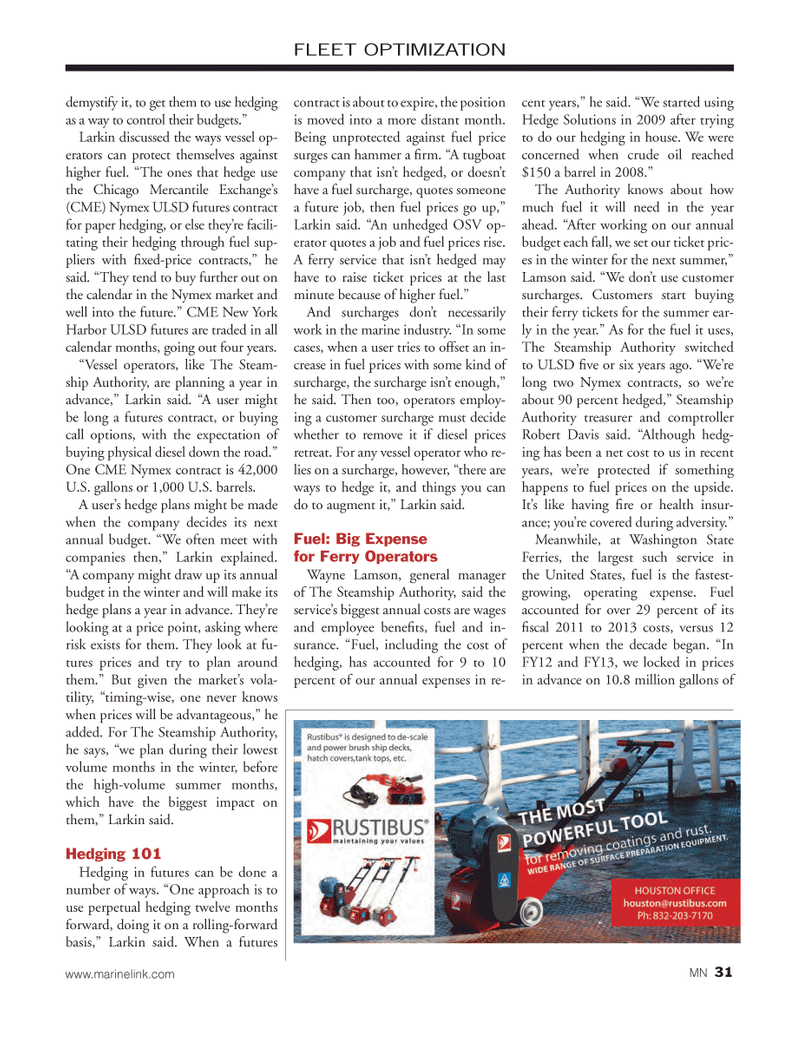
Page 31: of Marine News Magazine (March 2014)
Fleet & Vessel Optimization
Read this page in Pdf, Flash or Html5 edition of March 2014 Marine News Magazine
FLEET OPTIMIZATION demystify it, to get them to use hedging as a way to control their budgets.”
Larkin discussed the ways vessel op- erators can protect themselves against higher fuel. “The ones that hedge use the Chicago Mercantile Exchange’s (CME) Nymex ULSD futures contract for paper hedging, or else they’re facili- tating their hedging through fuel sup- pliers with fi xed-price contracts,” he said. “They tend to buy further out on the calendar in the Nymex market and well into the future.” CME New York
Harbor ULSD futures are traded in all calendar months, going out four years. “Vessel operators, like The Steam- ship Authority, are planning a year in advance,” Larkin said. “A user might be long a futures contract, or buying call options, with the expectation of buying physical diesel down the road.”
One CME Nymex contract is 42,000
U.S. gallons or 1,000 U.S. barrels.
A user’s hedge plans might be made when the company decides its next annual budget. “We often meet with companies then,” Larkin explained. “A company might draw up its annual budget in the winter and will make its hedge plans a year in advance. They’re looking at a price point, asking where risk exists for them. They look at fu- tures prices and try to plan around them.” But given the market’s vola- tility, “timing-wise, one never knows when prices will be advantageous,” he added. For The Steamship Authority, he says, “we plan during their lowest volume months in the winter, before the high-volume summer months, which have the biggest impact on them,” Larkin said.
Hedging 101
Hedging in futures can be done a number of ways. “One approach is to use perpetual hedging twelve months forward, doing it on a rolling-forward basis,” Larkin said. When a futures contract is about to expire, the position is moved into a more distant month.
Being unprotected against fuel price surges can hammer a fi rm. “A tugboat company that isn’t hedged, or doesn’t have a fuel surcharge, quotes someone a future job, then fuel prices go up,”
Larkin said. “An unhedged OSV op- erator quotes a job and fuel prices rise.
A ferry service that isn’t hedged may have to raise ticket prices at the last minute because of higher fuel.”
And surcharges don’t necessarily work in the marine industry. “In some cases, when a user tries to offset an in- crease in fuel prices with some kind of surcharge, the surcharge isn’t enough,” he said. Then too, operators employ- ing a customer surcharge must decide whether to remove it if diesel prices retreat. For any vessel operator who re- lies on a surcharge, however, “there are ways to hedge it, and things you can do to augment it,” Larkin said.
Fuel: Big Expense for Ferry Operators
Wayne Lamson, general manager of The Steamship Authority, said the service’s biggest annual costs are wages and employee benefi ts, fuel and in- surance. “Fuel, including the cost of hedging, has accounted for 9 to 10 percent of our annual expenses in re- cent years,” he said. “We started using
Hedge Solutions in 2009 after trying to do our hedging in house. We were concerned when crude oil reached $150 a barrel in 2008.”
The Authority knows about how much fuel it will need in the year ahead. “After working on our annual budget each fall, we set our ticket pric- es in the winter for the next summer,”
Lamson said. “We don’t use customer surcharges. Customers start buying their ferry tickets for the summer ear- ly in the year.” As for the fuel it uses,
The Steamship Authority switched to ULSD fi ve or six years ago. “We’re long two Nymex contracts, so we’re about 90 percent hedged,” Steamship
Authority treasurer and comptroller
Robert Davis said. “Although hedg- ing has been a net cost to us in recent years, we’re protected if something happens to fuel prices on the upside.
It’s like having fi re or health insur- ance; you’re covered during adversity.”
Meanwhile, at Washington State
Ferries, the largest such service in the United States, fuel is the fastest- growing, operating expense. Fuel accounted for over 29 percent of its fi scal 2011 to 2013 costs, versus 12 percent when the decade began. “In
FY12 and FY13, we locked in prices in advance on 10.8 million gallons of www.marinelink.com MN 31
MN MAR14 Layout 18-31.indd 31 2/21/2014 3:23:46 PM

 30
30

 32
32
